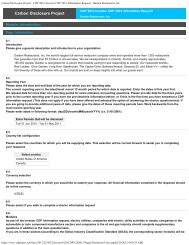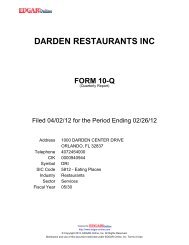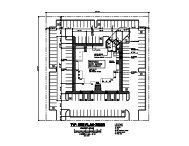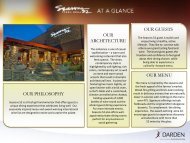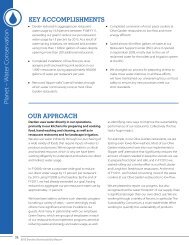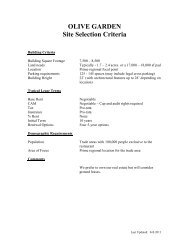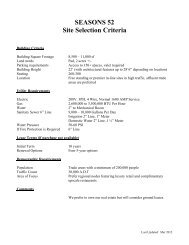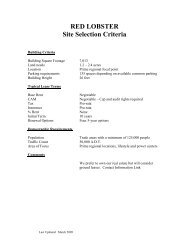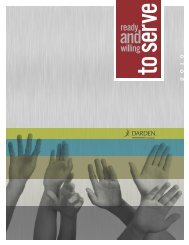2013 Annual Report - Investor Relations - Darden Restaurants
2013 Annual Report - Investor Relations - Darden Restaurants
2013 Annual Report - Investor Relations - Darden Restaurants
You also want an ePaper? Increase the reach of your titles
YUMPU automatically turns print PDFs into web optimized ePapers that Google loves.
Notes to Consolidated Financial Statements<strong>Darden</strong>companies with similar operating and investment characteristics of the reportingunits. If the fair value of the reporting unit is higher than its carrying value,goodwill is deemed not to be impaired, and no further testing is required. If thecarrying value of the reporting unit is higher than its fair value, there is an indicationthat impairment may exist and the second step must be performed to measurethe amount of impairment loss. The amount of impairment is determined bycomparing the implied fair value of reporting unit goodwill to the carrying valueof the goodwill in the same manner as if the reporting unit was being acquiredin a business combination. Specifically, fair value is allocated to all of the assetsand liabilities of the reporting unit, including any unrecognized intangible assets,in a hypothetical analysis that would calculate the implied fair value of goodwill.If the implied fair value of goodwill is less than the recorded goodwill, we wouldrecord an impairment loss for the difference.Consistent with our accounting policy for goodwill and trademarks weperformed our annual impairment test of our goodwill and trademarks as of thefirst day of our fiscal <strong>2013</strong> fourth quarter. As of the beginning of our fiscal fourthquarter, we had eight reporting units, six of which had goodwill: Red Lobster,Olive Garden, LongHorn Steakhouse, The Capital Grille, Eddie V’s and Yard House.As part of our process for performing the step one impairment test of goodwill,we estimated the fair value of our reporting units utilizing the income and marketapproaches described above to derive an enterprise value of the Company. Wereconciled the enterprise value to our overall estimated market capitalization. Theestimated market capitalization considers recent trends in our market capitalizationand an expected control premium, based on comparable recent and historicaltransactions. Based on the results of the step one impairment test, no impairmentof goodwill was indicated. As we finalized the purchase price allocation for YardHouse during our fourth fiscal quarter of <strong>2013</strong>, we excluded the goodwill allocatedto Yard House from our step one impairment test, however, we did perform aqualitative assessment of the goodwill allocated to Yard House in accordance withFinancial Accounting Standards Board (FASB) Accounting Standards Codification(ASC) Topic 350, Intangibles – Goodwill and Other, and no indicators of impairmentwere identified.The fair value of trademarks are estimated and compared to the carryingvalue. We estimate the fair value of trademarks using the relief-from-royaltymethod, which requires assumptions related to projected sales from our annuallong-range plan; assumed royalty rates that could be payable if we did not ownthe trademarks; and a discount rate. We recognize an impairment loss when theestimated fair value of the trademarks is less than its carrying value. We completedour impairment test and concluded as of the date of the test, there was noimpairment of the trademarks for LongHorn Steakhouse, The Capital Grille andEddie V’s. As we finalized the purchase price allocation for Yard House during ourfourth fiscal quarter of <strong>2013</strong>, we excluded the trademark related to Yard House fromour annual impairment test, however, we did perform a qualitative assessmentof the Yard House trademark in accordance with ASC Topic 350, Intangibles –Goodwill and Other, and no indicators of impairment were identified.We determined that there was no goodwill or trademark impairment as ofthe first day of our fourth fiscal quarter and no additional indicators of impairmentwere identified through the end of our fourth fiscal quarter that would requireus to test further for impairment. However, declines in our market capitalization(reflected in our stock price) as well as in the market capitalization of othercompanies in the restaurant industry, declines in sales at our restaurants, andsignificant adverse changes in the operating environment for the restaurantindustry may result in future impairment.Changes in circumstances, existing at the measurement date or at othertimes in the future, or in the numerous estimates associated with management’sjudgments and assumptions made in assessing the fair value of our goodwill,could result in an impairment loss of a portion or all of our goodwill or trademarks.If we recorded an impairment loss, our financial position and results of operationswould be adversely affected and our leverage ratio for purposes of our creditagreement would increase. A leverage ratio exceeding the maximum permittedunder our credit agreement would be a default under our credit agreement. AtMay 26, <strong>2013</strong>, a write down of goodwill, other indefinite-lived intangible assets,or any other assets in excess of approximately $810.0 million would have beenrequired to cause our leverage ratio to exceed the permitted maximum. As ourleverage ratio is determined on a quarterly basis and due to the seasonal natureof our business, a lesser amount of impairment in future quarters could causeour leverage ratio to exceed the permitted maximum.We evaluate the useful lives of our other intangible assets, to determineif they are definite or indefinite-lived. A determination on useful life requiressignificant judgments and assumptions regarding the future effects of obsolescence,demand, competition, other economic factors (such as the stability of theindustry, legislative action that results in an uncertain or changing regulatoryenvironment, and expected changes in distribution channels), the level ofrequired maintenance expenditures, and the expected lives of other relatedgroups of assets.Impairment or Disposal ofLong-Lived AssetsLand, buildings and equipment and certain other assets, including definite-livedintangible assets, are reviewed for impairment whenever events or changes incircumstances indicate that the carrying amount of an asset may not be recoverable.Recoverability of assets to be held and used is measured by a comparisonof the carrying amount of the assets to the future undiscounted net cash flowsexpected to be generated by the assets. Identifiable cash flows are measured atthe lowest level for which they are largely independent of the cash flows of othergroups of assets and liabilities, generally at the restaurant level. If such assets aredetermined to be impaired, the impairment recognized is measured by theamount by which the carrying amount of the assets exceeds their fair value. Fairvalue is generally determined based on appraisals or sales prices of comparableassets. Restaurant sites and certain other assets to be disposed of are reportedat the lower of their carrying amount or fair value, less estimated costs to sell.Restaurant sites and certain other assets to be disposed of are included in assetsheld for disposal within prepaid expenses and other current assets in our consolidatedbalance sheets when certain criteria are met. These criteria include therequirement that the likelihood of disposing of these assets within one year isprobable. Assets not meeting the “held for sale” criteria remain in land, buildingsand equipment until their disposal is probable within one year.We account for exit or disposal activities, including restaurant closures, inaccordance with Financial Accounting Standards Board (FASB) Accounting StandardsCodification (ASC) Topic 420, Exit or Disposal Cost Obligations. Such costs includethe cost of disposing of the assets as well as other facility-related expenses frompreviously closed restaurants. These costs are generally expensed as incurred.Additionally, at the date we cease using a property under an operating lease, werecord a liability for the net present value of any remaining lease obligations, netof estimated sublease income. Any subsequent adjustments to that liability as aresult of lease termination or changes in estimates of sublease income are recorded42 <strong>Darden</strong> <strong>Restaurants</strong>, Inc. <strong>2013</strong> <strong>Annual</strong> <strong>Report</strong>




